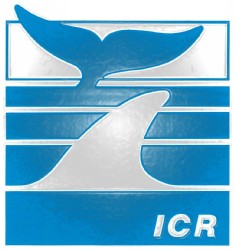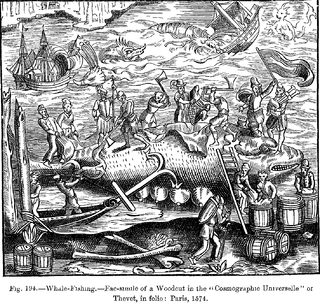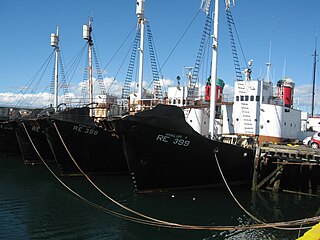
The International Convention for the Regulation of Whaling is an international environmental agreement signed in 1946 in order to "provide for the proper conservation of whale stocks and thus make possible the orderly development of the whaling industry". It governs the commercial, scientific, and aboriginal subsistence whaling practices of eighty-nine member nations.

Whaling is the hunting of whales for their usable products such as meat and blubber, which can be turned into a type of oil which became increasingly important in the Industrial Revolution. It was practiced as an organized industry as early as 875 AD. By the 16th century, it had risen to be the principal industry in the coastal regions of Spain and France. The industry spread throughout the world, and became increasingly profitable in terms of trade and resources. Some regions of the world's oceans, along the animals' migration routes, had a particularly dense whale population, and became the targets for large concentrations of whaling ships, and the industry continued to grow well into the 20th century. The depletion of some whale species to near extinction led to the banning of whaling in many countries by 1969, and to a worldwide cessation of whaling as an industry in the late 1980s.

The International Whaling Commission (IWC) is an international body set up by the terms of the International Convention for the Regulation of Whaling (ICRW), which was signed in Washington, D.C., United States, on 2 December 1946 to "provide for the proper conservation of whale stocks and thus make possible the orderly development of the whaling industry".

The common minke whale or northern minke whale is a species of minke whale within the suborder of baleen whales.

Ulsan, officially the Ulsan Metropolitan City, is South Korea's seventh-largest metropolitan city and the eighth-largest city overall, with a population of over 1.1 million inhabitants. It is located in the south-east of the country, neighboring Busan to the south and facing Gyeongju to the north.

The Institute of Cetacean Research: is a non-profit organisation in Japan which claims to be a research organization specializing in the "biological and social sciences related to whales".

Taiji is a town located in Higashimuro District, Wakayama Prefecture, Japan.

Japanese whaling, in terms of active hunting of whales, is estimated by the Japan Whaling Association to have begun around the 12th century. However, Japanese whaling on an industrial scale began around the 1890s when Japan started to participate in the modern whaling industry, at that time an industry in which many countries participated. Modern Japanese whaling activities have extended far outside Japanese territorial waters, including whale sanctuaries protected by other countries.

This article discusses the history of whaling from prehistoric times up to the commencement of the International Whaling Commission (IWC) moratorium on commercial whaling in 1986. Whaling has been an important subsistence and economic activity in multiple regions throughout human history. Commercial whaling dramatically reduced in importance during the 19th century due to the development of alternatives to whale oil for lighting, and the collapse in whale populations. Nevertheless, some nations continue to hunt whales even today.

Whaling in Iceland began with spear-drift hunting as early as the 12th century, and continued in a vestigial form until the late 19th century, when other countries introduced modern commercial practices. Today, Iceland is one of a handful of countries that formally object to an ongoing moratorium established by the International Whaling Commission in 1986, and that still maintain a whaling fleet. One company concentrates on hunting fin whales, largely for export to Japan, while the only other one hunts minke whales for domestic consumption, as the meat is popular with tourists. In 2018, Icelandic whalers were accused of slaughtering a blue whale.
Whaling in Norway involves subsidized hunting of minke whales for use as animal and human food in Norway and for export to Japan. Whale hunting has been a part of Norwegian coastal culture for centuries, and commercial operations targeting the minke whale have occurred since the early 20th century. Some still continue the practice in the modern day.

The Nisshin Maru (日新丸) is the primary vessel of the Japanese whaling fleet and is the world's only whaler factory ship. It has a tonnage of 8,145 GT and is the largest member and flagship of the five-ship whaling fleet, headed by leader Shigetoshi Nishiwaki. The ship is based in Japan in Shimonoseki harbor and is owned by Tokyo-based Kyodo Senpaku, which is a subsidiary of the Institute of Cetacean Research.

The International Whaling Commission meeting in 2005 was held in Ulsan, South Korea from 20 June–24 June 2005. This meeting saw discussion and vote upon several particularly divisive matters. Notable among them were three defeated Japanese proposals:
The Southern Ocean Whale Sanctuary is an area of 50 million square kilometres surrounding the continent of Antarctica where the International Whaling Commission (IWC) has banned all types of commercial whaling. To date, the IWC has designated two such sanctuaries, the other being the Indian Ocean Whale Sanctuary.

Nam District (Nam-gu) is a district of Ulsan, South Korea. Its name literally means "South Ward".

Commercial whaling in the United States dates to the 17th century in New England. The industry peaked in 1846–1852, and New Bedford, Massachusetts, sent out its last whaler, the John R. Mantra, in 1927. The Whaling industry was engaged with the production of three different raw materials: whale oil, spermaceti oil, and whalebone. Whale oil was the result of "trying-out" whale blubber by heating in water. It was a primary lubricant for machinery, whose expansion through the Industrial Revolution depended upon before the development of petroleum-based lubricants in the second half of the 19th century.

Whale conservation is the international environmental and ethical debate over whale hunting. The conservation and anti-whaling debate has focused on issues of sustainability as well as ownership and national sovereignty. Also raised in conservation efforts is the question of cetacean intelligence, the level of suffering which the animals undergo when caught and killed, and the importance that the mammals play in the ecosystem and a healthy marine environment.

Anti-whaling refers to actions taken by those who seek to end whaling in various forms, whether locally or globally in the pursuit of marine conservation. Such activism is often a response to specific conflicts with pro-whaling countries and organizations that practice commercial whaling and/or research whaling, as well as with indigenous groups engaged in subsistence whaling. Some anti-whaling factions have received criticism and legal action for extreme methods including violent direct action. The term anti-whaling may also be used to describe beliefs and activities related to these actions.

Marine mammals are a food source in many countries around the world. Historically, they were hunted by coastal people, and in the case of aboriginal whaling, still are. This sort of subsistence hunting was on a small scale and produced only localised effects. Dolphin drive hunting continues in this vein, from the South Pacific to the North Atlantic. The commercial whaling industry and the maritime fur trade, which had devastating effects on marine mammal populations, did not focus on the animals as food, but for other resources, namely whale oil and seal fur.
Jangsaengpo Whale Museum is a history museum located in Jangsaengpo, Nam-gu, Ulsan, South Korea. It is the only whale museum in South Korea. The museum details Ulsan's history of whaling. Whaling was banned in South Korea in 1986, but whaling artifacts were kept and are now on display in the museum which is built in what was once a central whaling area. It has a 6,946 square metres of floor space and includes a dolphinarium where visitors can watch dolphin acrobatic performances, and a 4D theatre.